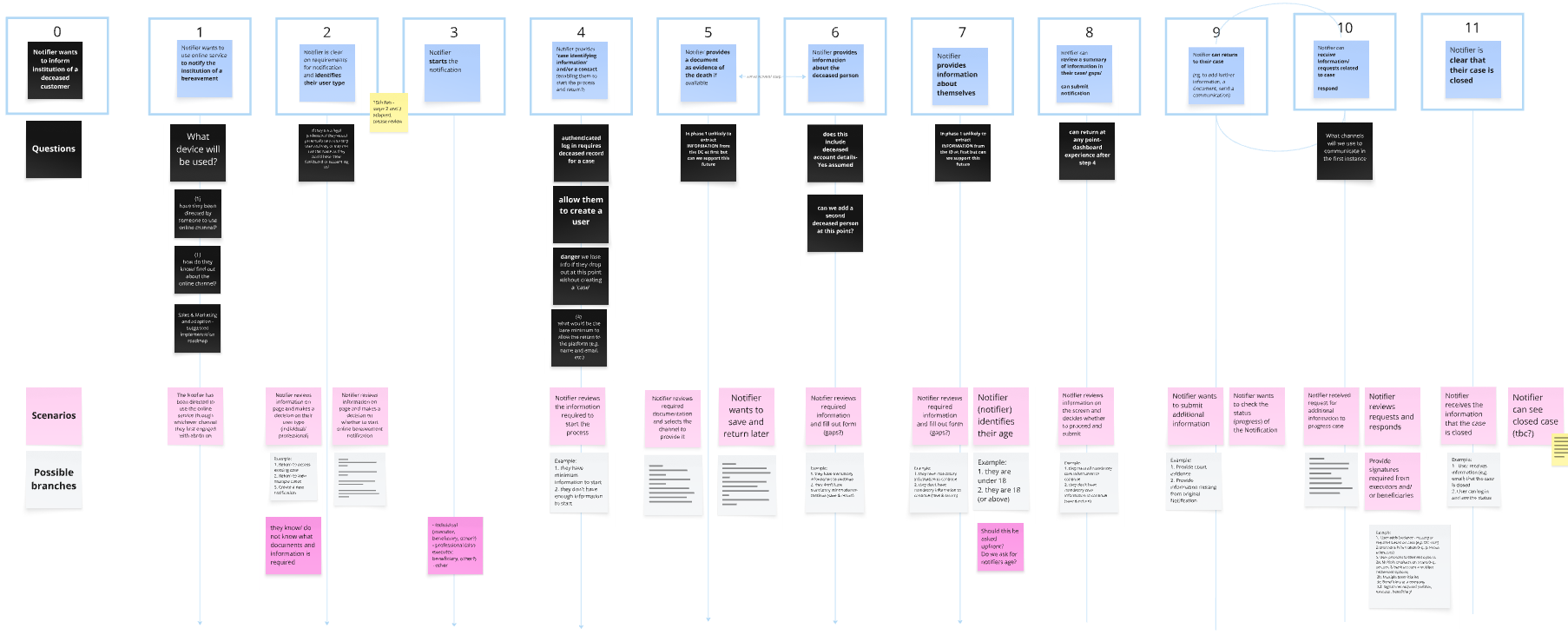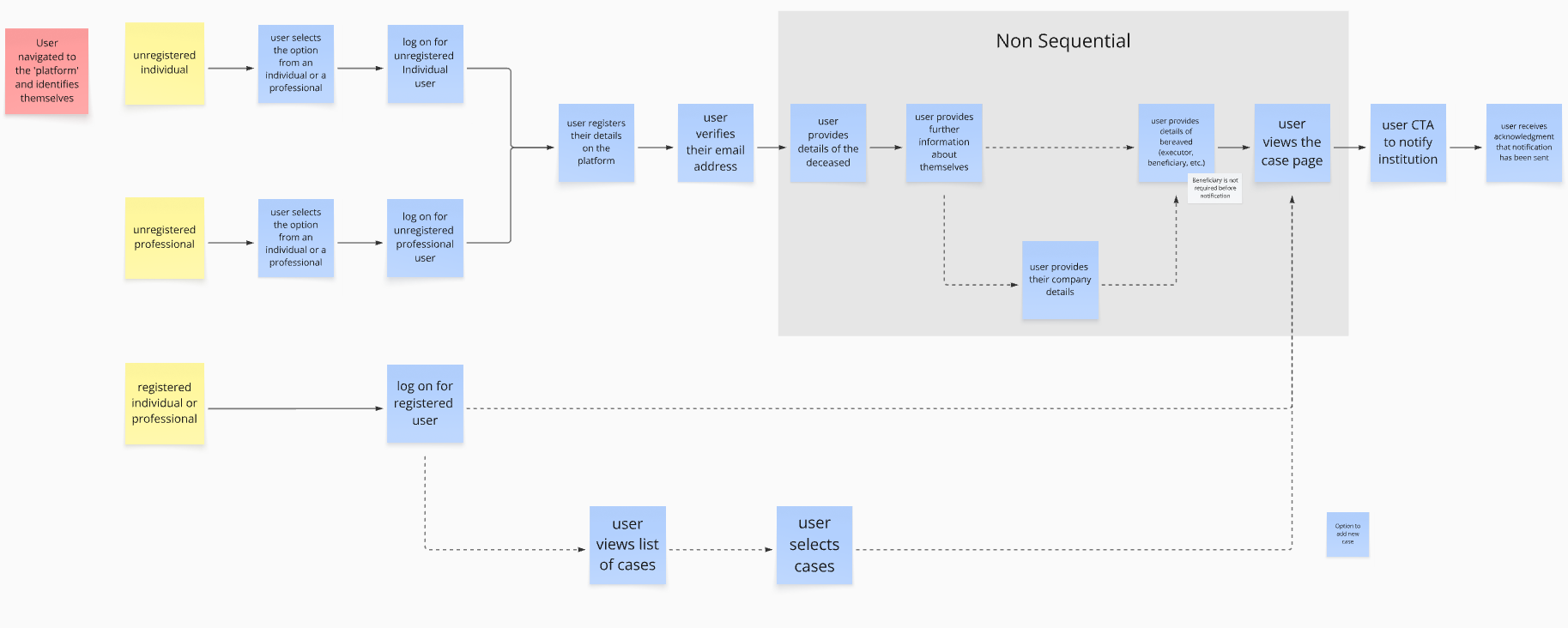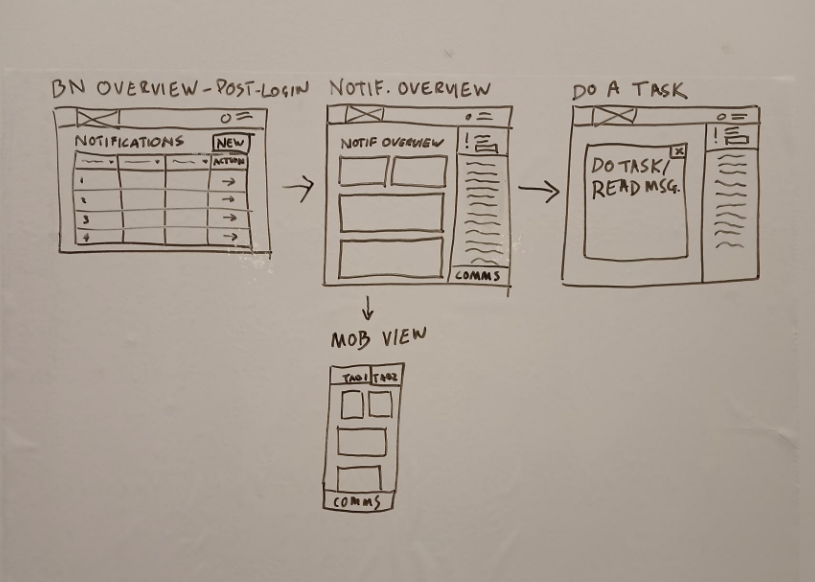Bereavement Notification Portal
This project aimed to transform the notifier experience by significantly enhancing the notification and settlement journey when an individual informs a financial institution of a customer’s bereavement.
Project role: Digital Product Designer & User Researcher
Project length: 18 months
Project overview
Notifiers—those responsible for informing institutions of a death—often face a deeply stressful and confusing experience. The bereavement process is typically fragmented, requiring individuals to contact multiple organizations separately, often repeating the same information through manual forms or phone calls. This lack of a centralized system leads to delays, poor communication, and a lack of transparency. Many notifiers report feeling overwhelmed, unsupported, and unsure of what steps to take, all while coping with emotional loss. These inefficiencies not only prolong the process but also contribute to a significant decline in mental well-being during an already difficult time.
Initial research findings
To uncover the key challenges within the bereavement notification process, a series of in-depth user interviews were conducted with two primary groups: Bereavement Operations team members from a range of financial institutions, and individuals who had recently acted as notifiers following the death of a loved one. These conversations provided valuable, first-hand insights into both the institutional and personal sides of the process.
Operations staff highlighted systemic inefficiencies, such as manual workflows, inconsistent communication, and regulatory pressures. Meanwhile, notifiers shared emotionally resonant stories of confusion, repeated effort, and a lack of support during an already difficult time.
This dual-perspective approach ensured a well-rounded understanding of the pain points, helping to shape a solution that would be both operationally effective and genuinely empathetic to the needs of bereaved individuals.
Emotional Burden on Notifiers
Many notifiers felt overwhelmed and unsupported, with the administrative burden negatively impacting their mental well-being.
Fragmented and Manual Processes
The bereavement process was fragmented even within individual institutions, often requiring notifiers to engage with multiple departments through different channels—such as phone, email, and post—leading to confusion, duplication, and delays.
Lack of Transparency and Communication
Notifiers were frustrated by poor communication and lack of visibility, with no central system to track progress or receive updates.
Repetitive Information Requests
Notifiers were often required to repeat the same information and submit the same documents to different organizations, increasing stress and time spent.
Limited Digital Support
Digital solutions were rare and inconsistent, highlighting a strong need for a secure, user-friendly platform to simplify the bereavement process.
Regulatory and Compliance Gaps
Institutions faced challenges in meeting FCA guidelines for treating bereaved customers fairly, due to outdated systems and inconsistent practices.
Process mapping
This project began after discussions with bereavement operations teams at several financial institutions, who highlighted the inefficiencies and emotional strain of their existing processes. The reliance on paper forms and postal communication often meant that notifications and responses took several weeks—or even months—to complete, frustrating both notifiers and staff. These concerns were echoed in interviews with individuals who had recently gone through the process, revealing common themes of confusion, repetition, and lack of support.
With these insights, we defined a new digital journey aligned with FCA guidance and collaborated with institutions through co-design workshops to shape the content and functionality at each stage. The result is a solution that is not only compliant and efficient but also empathetic and user-focused, setting a new benchmark for bereavement support.
Focus on communication
During the user interview research sessions, it became evident that the most vital aspect of the overall holistic service for a Notifier was maintaining a clear and consistent line of communication. Whether it involved receiving timely updates about the progress of a bereavement notification or being prompted to submit supporting information or documentation, users consistently emphasized the importance of feeling informed and connected throughout the process. For this reason, we made communication the central focus of the project, ensuring that Notifiers had a consistent and reliable place to receive updates and requests from the institution.
Building on this focus, we began developing an in-platform messaging system to facilitate direct and timely communication. Alongside this, we introduced a dedicated task section with clear status indicators, allowing Notifiers to easily track outstanding actions and see what had already been completed. This approach aimed to reduce uncertainty and provide a more transparent, supportive experience during a difficult time.
Iterative Design and Usability Testing
To ensure the platform met the needs of both professional and personal users, we conducted multiple rounds of usability sessions and design reviews throughout the project. These sessions involved two key groups: legal professionals working in the bereavement and probate sector, and individuals we had previously engaged during the initial user interview phase.
By involving legal experts, we were able to validate the platform’s alignment with industry standards and workflows, ensuring that the features and language used were appropriate and practical for professional use. At the same time, re-engaging earlier interview participants allowed us to maintain a strong connection to the lived experiences and expectations of Notifiers, ensuring the platform remained intuitive and empathetic.
Each round of feedback was used to refine the design and steer the next phase of development, helping us identify usability issues early and prioritize improvements that would have the greatest impact. This iterative approach was instrumental in helping us achieve the project’s aim of creating a clear, supportive, and user-friendly experience for all stakeholders involved.
Project outcome
The implementation of Exizent’s Bereavement Notification Platform directly supports the project’s core aim: to improve the experience for notifiers when contacting financial institutions about a bereavement. Traditionally, this process was fragmented, manual, and emotionally taxing—requiring notifiers to navigate multiple departments, repeat information, and manage paper-based communication during an already difficult time. The platform addresses these challenges by providing a centralised, intuitive, and supportive digital journey, allowing notifiers to submit and manage notifications through a secure online portal. With features like real-time updates, clear guidance, and encrypted communication, the platform reduces confusion and emotional strain.
As a white-label SaaS solution, the platform is implemented by financial institutions and fully branded to reflect their customer experience. This enables organisations to deliver a consistent, compassionate, and efficient service under their own identity, while significantly easing the burden on notifiers. The result is a more informed, supported, and in-control experience for individuals navigating bereavement—transforming a once stressful and disjointed process into one that is empathetic, streamlined, and fit for the digital age.










